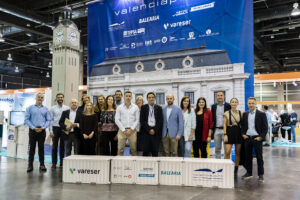
The Port Authority of Valencia (PAV) has reproduced the emblematic building with a 6-metre recycled cardboard model
Valenciaport and the port community presented their strategy in the fight against climate change and decarbonisation at this event
Among the initiatives that visitors have been able to see are the solar plant projects, the use of hydrogen and the installation of wind energy
The companies Baleària, Tepsa, Vareser and Seroil-Reciclamás are participating in the PAV space
The collaboration of Amarradores del Puerto de València, Galp, Garbaport, InterSagunto, APM Terminals Valencia, Valencia Terminal Europa, Docks Logistics and MSC Terminal Valencia has also been counted on
València, October 10th, 2022.- A six-metre high recreation made of recycled cardboard of the iconic Clock Building of the Port of Valencia presided over the stand of the Port Authority of Valencia (PAV) at this year’s edition of the International Fair of Environmental Solutions and Ecological Transition (ECOFIRA) which was held from 4 to 6 October at Feria Valencia.
An image that has surprised visitors to this event who have stopped at the Valenciaport space to learn about the projects being developed in the common goal of the port community to be emission neutral by 2030. In the spectacular setting of the Clock Building, the PAV showed the work it is carrying out to improve energy efficiency in the areas it manages.
The Valenciaport stand at this fair also included the companies Baleària, Tepsa, Vareser and Seroil-Reciclamás, as well as the collaboration of Amarradores del Puerto de València, Galp, Garbaport, InterSagunto, APM Terminals Valencia, Valencia Terminal Europa, Docks Logistics and MSC Terminal Valencia.
Among these actions, it is worth highlighting the installation of two solar plants in the Port of Valencia which have already been put out to tender and which, once in operation, will represent 14% of the energy consumed by the port precinct. Along the same lines, the photovoltaic installation in shed 4 of the Port of Gandia will make this infrastructure the first port to be self-sufficient.
The visitors to ECOFIRA were also able to find out about projects such as H2Ports, which will make the Port of Valencia the first European port to use hydrogen in port operations. In addition, other initiatives such as the location of wind turbines, the fleet of electric vehicles of Valenciaport, the actions implemented by the port companies in Ecoport such as waste management, the reduction of energy or water consumption, among others, have been highlighted.
From 2008 to 2019, the carbon footprint of the Port of Valencia has been reduced by 30%, from 3.19 to 2.23 kg of CO2 per tonne handled. In the same period, the activity of Valenciaport grew by 42%, going from 52 million tonnes handled in 2008 to 74 million tonnes handled at the close of the 2019 financial year.

